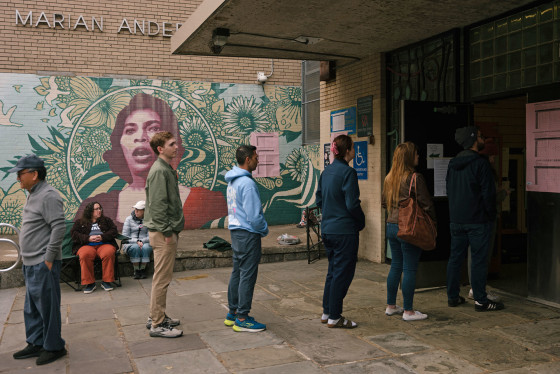
According to a recent NBC News Decision Desk study of precinct-level data, low attendance in overwhelmingly Democratic cities was a major factor in Vice President Kamala Harris’ defeats and President-elect Donald Trump’s victories in Michigan, Wisconsin, and Pennsylvania.
Harris’s most obvious route to victory heading into Election Day was to win all three of the traditional blue wall states. She ultimately lost in all three, and the almost finished vote count in those states demonstrates how the number of votes decreased in some of the most Democratic-friendly regions of those states as compared to 2020.
Harris’s percentage of the vote and the percentage change in the total number of votes cast in the presidential campaign relative to the total number of votes cast in 2020 are depicted in the charts below. A county is represented by each dot; counties with more voters in 2024 than in 2020 are represented by dots above the 0% line, while counties with fewer voters in 2024 than in 2020 are represented by the comparatively small number of dots below that line.
The diagonal black lines indicate that in all three states, the turnout was lower in the highly Republican counties on the left side of each panel than in the heavily Democratic counties on the right, compared to 2020. The largest county in each state Wayne County, Michigan, home of Detroit; Philadelphia County, Pennsylvania; and Milwaukee County, Wisconsin had either the worst or second-worst shift in votes cast of any county in their state.
In the 2020 and 2022 elections, the Democratic Party’s electoral triumph was powered by these three underperforming counties and their cities. Harris garnered a slightly smaller proportion of the vote than Joe Biden in 2020, despite winning all three of these cities handily by more than 50 percentage points apiece. But more importantly, Trump’s win was fueled by the declining or stagnating vote in these cities as well as the rise in turnout in Republican counties across the blue wall.
This Philadelphia map illustrates the decline in turnout between 2020 and 2024. The map’s purple areas show precincts where fewer votes were cast overall in 2024 compared to 2020, whereas the green precincts saw a rise in the number of votes.
Seventy-three percent of Philadelphia’s more than 1,700 precincts had fewer voters in 2024 than in 2020. There were about 20,000 fewer voters in Philadelphia this year as a result of a 2.9% drop in the overall number of ballots cast. In contrast, the total number of voters in the remainder of Pennsylvania increased by 2.1% from 2020.
Turnout shifts in Detroit, which accounts for roughly one-third of Wayne County’s population, are depicted on the following map. The decline in turnout in Detroit was considerably as severe than that in Philadelphia. Detroit’s voting turnout decreased by 4%, while the rest of Michigan saw a 2.6% increase.
The overall number of votes tended to be lower than higher in the precincts in the northern portion of Detroit, where the majority of voters are Black. According to the NBC News Exit Poll, Harris lost nine votes for every ten voters who did not cast a ballot, while Trump lost only one, despite the fact that Harris had almost as much support from Black voters in Michigan as Biden (89% versus 92%, respectively).
If not for higher turnout in the Latino areas in the city’s central-southern region, Detroit’s overall turnout decline would have been considerably more pronounced. However, Harris might not have benefited from this increase in turnout. In Michigan, Joe Biden garnered a majority of the Latino vote in 2020, whereas Trump carried the vote in 2024, according to the NBC News Exit Poll.
Milwaukee, which accounts for around 60% of the population of Milwaukee County, is the third major blue wall city. In contrast to Philadelphia and Detroit, Milwaukee’s vote total actually went up by around half a percentage point since 2020. In contrast, Wisconsin’s voter turnout increased by 4% from 2020.
The Milwaukee precinct map displays a patchwork of both higher and lower turnout. While the city’s turnout increased somewhat overall, just over half of precincts (58%) saw a decline in turnout. It is possible to demonstrate how differing demographics may account for variations in turnout by contrasting Milwaukee’s low turnout with Dane County, Wisconsin’s other sizable Democratic county, where turnout rose by more than 6%. Although Harris received about three-quarters of the votes in both Dane County and the city of Milwaukee, their demographics are very different.
The primary distinction between Dane County and Milwaukee is that, during the past few years, Dane County’s population has increased quickly, whereas Milwaukee’s has been falling. Democratic candidates will need to rely more on voters outside of Philadelphia and Detroit if Milwaukee’s population decrease pattern, which also happened in those areas, continues.
Other significant demographic distinctions exist between Dane County and Milwaukee. White and non-Hispanic people make up about 35% of Milwaukee’s population. In contrast, around 84% of the people living in Dane County are non-Hispanic white. In addition, just around 25% of Milwaukee’s population holds a college degree, but more than 50% of Dane County citizens do.
This disparity is noteworthy since, according to the NBC News Exit Poll, Wisconsin voters with college degrees were among the few demographic groups where Harris outperformed Joe Biden’s 2020 vote results.
Note: Thank you for visiting our website! We strive to keep you informed with the latest updates based on expected timelines, although please note that we are not affiliated with any official bodies. Our team is committed to ensuring accuracy and transparency in our reporting, verifying all information before publication. We aim to bring you reliable news, and if you have any questions or concerns about our content, feel free to reach out to us via email. We appreciate your trust and support!
